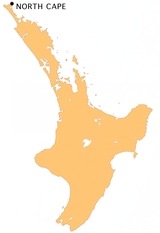
Surville Cliffs
Encyclopedia
The Surville Cliffs are the northernmost point of the mainland of New Zealand
. They are situated on the North Cape
of the North Island
, 30 kilometres to the east of Cape Reinga
(which is often mistaken as New Zealand's northernmost point), and three kilometres more northerly. In the past the cliffs have sometimes been referred to as Kerr Point but true Kerr Point lies a short distance away at the western end of North Cape.
The first European discovery of the cliffs was made by Jean-François-Marie de Surville
in December 1769, when he sailed his ship 'St Jean Baptiste' to New Zealand to find a safe anchorage to care for sick crew. He found them only a few days before they were seen by James Cook
.
mafic
rocks. They form a unique environment that supports a number of threatened and endangered plants endemic to the area, including:
New Zealand
New Zealand is an island country in the south-western Pacific Ocean comprising two main landmasses and numerous smaller islands. The country is situated some east of Australia across the Tasman Sea, and roughly south of the Pacific island nations of New Caledonia, Fiji, and Tonga...
. They are situated on the North Cape
North Cape, New Zealand
North Cape is located at the northern end of the North Auckland Peninsula in the North Island of New Zealand . It is the northeastern tip of the Aupouri Peninsula and lies 30 km east of Cape Reinga. The name is sometimes used to refer just to the cape which is known in Māori as Otou and which...
of the North Island
North Island
The North Island is one of the two main islands of New Zealand, separated from the much less populous South Island by Cook Strait. The island is in area, making it the world's 14th-largest island...
, 30 kilometres to the east of Cape Reinga
Cape Reinga
Cape Reinga is the northwesternmost tip of the Aupouri Peninsula, at the northern end of the North Island of New Zealand. Cape Reinga is located over 100 km north of the nearest small town of Kaitaia. State Highway 1 extends all the way to the Cape, but until 2010 was unsealed gravel road for the...
(which is often mistaken as New Zealand's northernmost point), and three kilometres more northerly. In the past the cliffs have sometimes been referred to as Kerr Point but true Kerr Point lies a short distance away at the western end of North Cape.
The first European discovery of the cliffs was made by Jean-François-Marie de Surville
Jean-François-Marie de Surville
Jean-François-Marie de Surville was a French trader and navigator.In 1767 de Surville set sail in his ship, the St Jean Baptiste to India to trade between the French settlements in India and China...
in December 1769, when he sailed his ship 'St Jean Baptiste' to New Zealand to find a safe anchorage to care for sick crew. He found them only a few days before they were seen by James Cook
James Cook
Captain James Cook, FRS, RN was a British explorer, navigator and cartographer who ultimately rose to the rank of captain in the Royal Navy...
.
Local flora
The cliffs expose 1.2 square kilometres of serpentinised peridotitePeridotite
A peridotite is a dense, coarse-grained igneous rock, consisting mostly of the minerals olivine and pyroxene. Peridotite is ultramafic, as the rock contains less than 45% silica. It is high in magnesium, reflecting the high proportions of magnesium-rich olivine, with appreciable iron...
mafic
Mafic
Mafic is an adjective describing a silicate mineral or rock that is rich in magnesium and iron; the term is a portmanteau of the words "magnesium" and "ferric". Most mafic minerals are dark in color and the relative density is greater than 3. Common rock-forming mafic minerals include olivine,...
rocks. They form a unique environment that supports a number of threatened and endangered plants endemic to the area, including:
- PittosporumPittosporumPittosporum is a genus of about 200 species of flowering plants in the family Pittosporaceae. The genus is probably Gondwanan in origin; its present range extends from Australasia, Oceania, eastern Asia and some parts of Africa. Citriobatus is usually included here, but might be a distinct genus...
ellipticum subsp. serpentinum - HebeHebe (plant)Hebe is a genus of plants native to New Zealand, Rapa in French Polynesia, the Falkland Islands, and South America. It includes about 90 species and is the largest plant genus in New Zealand. Apart from H. rapensis , all species occur in New Zealand. This includes the two species, H. salicifolia...
brevifolia - HebeHebe (plant)Hebe is a genus of plants native to New Zealand, Rapa in French Polynesia, the Falkland Islands, and South America. It includes about 90 species and is the largest plant genus in New Zealand. Apart from H. rapensis , all species occur in New Zealand. This includes the two species, H. salicifolia...
ligustrifolia - Helichrysum aggregatum
- Leucopogon xerampelinus
- PimeleaPimeleaPimelea is a genus of plants belonging to the family Thymelaeaceae. There are about 80 species in the genus, native to Australia and New Zealand. Many of the species are poisonous to cattle.Selected species...
tomentosa (Sand Daphne) - Phyllocladus trichomanoidesPhyllocladus trichomanoidesPhyllocladus trichomanoides is a coniferous tree native to New Zealand.Tanekaha is a medium-sized forest tree growing up to 20 m in height and 1 m trunk diameter. The main structural shoots are green for 2–3 years, then turn brown as the bark thickens...
(Tanekaha) - Pseudopanax lessoniiPseudopanax lessoniiPseudopanax lessonii, or houpara, is a New Zealand native tree belonging to the family Araliaceae.Houpara is a shrub or tree up to 6 m tall, with stout branches. The leaves are crowded towards the tips of branchlets, and are 3- to 5- foliolate. Juvenile plants have larger leaves than adults...
(Coastal Fivefinger) - UnciniaUnciniaUncinia is a genus of flowering plants in the family Cyperaceae, known as hook-sedges in Australia and as hook grasses or bastard grasses in New Zealand...
perplexa (Surville Cliffs Bastard Grass)

